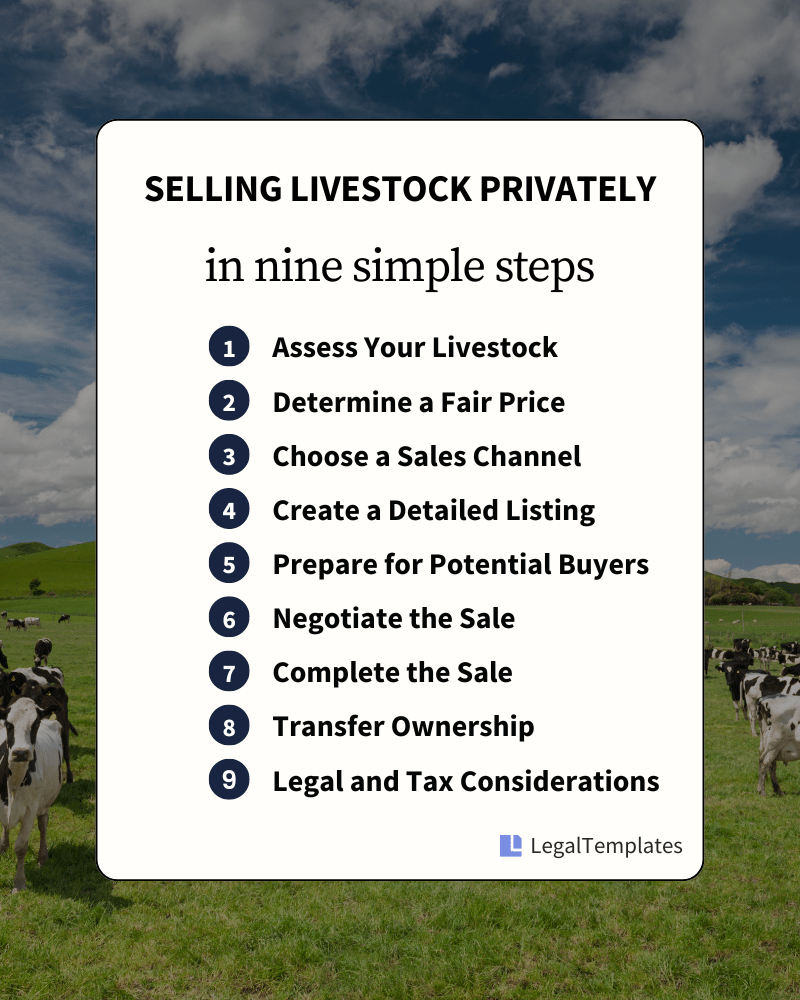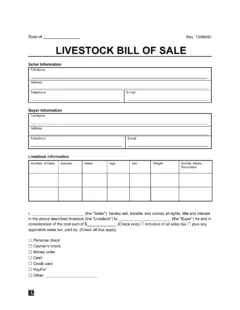
Use a livestock bill of sale form when selling farm or ranch animals.

Updated September 12, 2024
Written by Josh Sainsbury | Reviewed by Brooke Davis
A livestock bill of sale is a crucial document that documents the sale of livestock (such as cattle, sheep, horses, etc.) from one party to another. It serves important tax and legal functions, acting as proof of transaction for income reporting, expense deduction, and verifying the animals’ origin and ownership in line with regulations.
It may also be necessary for animal transportation across states or qualifying for agricultural programs.
Download: PDF or MS Word.
A livestock bill of sale safeguards both parties by providing clear documentation and legal protection, making the transaction smooth and secure.

Selling livestock privately requires careful planning and execution. Follow these steps to ensure a successful transaction:
Evaluate your livestock’s breed, age, gender, health, and any special attributes like pedigree verification, weight gain efficiency, and breeding soundness. This will help you set a competitive price.
Research market values for similar livestock to establish a fair asking price. Consider factors such as herd health management and market demand.
Advertise your livestock through appropriate channels. To reach potential buyers, consider websites like Craigslist, Livestock Market, or AgriSearch .
Draft an advertisement that includes clear photos and a detailed description of the livestock. Highlight key details such as breed, age, sex, health status, and any unique attributes. Emphasize the importance of full veterinary reports, including vaccination records and health certificates, to avoid disputes.
Be ready to respond to inquiries and arrange viewings. Provide comprehensive health documentation and answer all questions about the livestock.
Discuss and agree on terms with potential buyers, including price, payment method, and transportation costs. Ensure clarity on liability for accidents during transport and conditions for refunds if the livestock doesn’t meet expectations. Consider bulk purchase discounts and installment payment options.
Finalize the transaction with a livestock bill of sale. Include all relevant details and ensure both parties sign the document.
Get deposit agreements or non-refundable terms in writing to minimize risks if a buyer backs out.
Deliver the livestock or arrange for pickup as agreed. Ensure all necessary health documentation and legal requirements are met.
Verify local or state regulations for livestock transactions. Be aware of tax implications and the need to report sales for tax purposes. Ensure you have any required permits or registrations.
To ensure your livestock bill of sale is effective and legally binding, include the following key elements:
Ensure the bill of sale meets local and state requirements, which can vary.
Yes, a livestock bill of sale is legally binding as long as it includes essential details about the transaction and is signed by both parties.
Notarization is not typically required, but it can add an extra layer of verification and credibility.
Yes, a handwritten bill of sale is acceptable as long as it includes all necessary details and is signed by both the buyer and seller.

Create your Livestock Bill of Sale today!